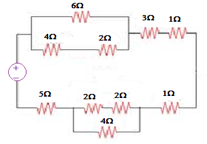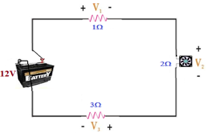PHY301 Assignment 1 Solution and Discussion
-
Assignment 1(Fall 2019)Circuit Theory (Phy301)
Marks: 20
Due Date: Nov 15, 2019
DON’T miss these important instructions:• To solve this assignment, you should have good command over first 7 lectures.
• Upload assignments properly through LMS, (No Assignment will be accepted through email).
• Write your ID on the top of your solution file.
• All students are directed to use the font and style of text as is used in this document.
• Don’t use colorful back grounds in your solution files.
• Use Math Type or Equation Editor etc for mathematical symbols.
• No excuse will be accepted by anyone if found to be copying or letting others copy.
• Don’t wait for the last date to submit your assignment.
• You can draw circuit diagrams in “Paint” in “Corel Draw” or in “circuit maker”. The simple and easy way is to copy the given image in Paint and do the required changes in it.Q. 1
Find the equivalent resistance (Req) of given circuit network across voltage source. Draw and label the circuit diagram of each step, otherwise you will lose your marks.
Q. 2
A 12V battery is connected to a circuit containing 2 resistors and a fan having 2Ω resistance.- Calculate the source current Is.
- Determine the voltages V1, V2, and V3.
- Calculate the power dissipated by each resistor.
- Determine the power delivered by the source, and compare it to the sum of the power levels of part (4)

-
Q. 1 Solution:
Starting from lower side of circuit network, we can see that 2Ω and 2Ω are in series, so their combined effect is
2+2=4Ω

This 4Ω is in parallel of 4Ω to lower side, so their equivalent is


This 2Ω is in series of 5Ω and 1Ω, so the sum of series resistances is
2Ω+ 5Ω+1Ω=8Ω

Now at upper side, 4Ω and 2Ω are in series
4Ω+ 2Ω=6Ω

This 6Ω is in parallel of 6Ω, so their equivalent is


This 3Ω is in series of 3Ω and 1Ω, so the sum of series is
3Ω+ 3Ω+1Ω=7Ω

Now we can see 7Ω becomes in series of 8Ω, so equivalent resistance is
Req =7Ω + 8Ω
Req=15ΩQ.2 Solution:
1)
To calculate the source current Is, Firstly, we calculate the total resistance
RT= R1+R2+R3
=6Ω
V=IR
IS=VS/RT
= 12/6
=2A2)
Since all resistances are in series, same 2A current pass through each resistance.
V1= R1IS
=12
=2V
V2=R2Is
=22
=4V
V3=R3IS
= 32
=6V3)
P1 =I2R1
= (2)2 *1
=4W
P2 =I2R2
= (2)2 *2
= 8W
P3 =I2R3
=(2)2 *3
= 12W
= 12W4)-
Ps = VsIs
P =122
=24 W
PT=P1+P2+P3 or PT=I2RT
=4+8+12
=24 W -
@zareen said in PHY301 Assignment 1 Solution and Discussion:
Find the equivalent resistance (Req) of given circuit network across voltage source. Draw and label the circuit diagram of each step, otherwise you will lose your marks.
@zareen said in PHY301 Assignment 1 Solution and Discussion:
A 12V battery is connected to a circuit containing 2 resistors and a fan having 2Ω resistance.
Calculate the source current Is.
Determine the voltages V1, V2, and V3.
Calculate the power dissipated by each resistor.
Determine the power delivered by the source, and compare it to the sum of the power levels of part (4)
-
Q. 1 Solution:
Starting from lower side of circuit network, we can see that 2Ω and 2Ω are in series, so their combined effect is
2+2=4Ω

This 4Ω is in parallel of 4Ω to lower side, so their equivalent is


This 2Ω is in series of 5Ω and 1Ω, so the sum of series resistances is
2Ω+ 5Ω+1Ω=8Ω

Now at upper side, 4Ω and 2Ω are in series
4Ω+ 2Ω=6Ω

This 6Ω is in parallel of 6Ω, so their equivalent is


This 3Ω is in series of 3Ω and 1Ω, so the sum of series is
3Ω+ 3Ω+1Ω=7Ω

Now we can see 7Ω becomes in series of 8Ω, so equivalent resistance is
Req =7Ω + 8Ω
Req=15ΩQ.2 Solution:
1)
To calculate the source current Is, Firstly, we calculate the total resistance
RT= R1+R2+R3
=6Ω
V=IR
IS=VS/RT
= 12/6
=2A2)
Since all resistances are in series, same 2A current pass through each resistance.
V1= R1IS
=12
=2V
V2=R2Is
=22
=4V
V3=R3IS
= 32
=6V3)
P1 =I2R1
= (2)2 *1
=4W
P2 =I2R2
= (2)2 *2
= 8W
P3 =I2R3
=(2)2 *3
= 12W
= 12W4)-
Ps = VsIs
P =122
=24 W
PT=P1+P2+P3 or PT=I2RT
=4+8+12
=24 W